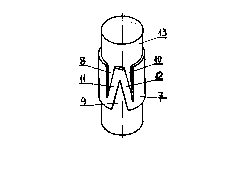Some of the information on this Web page has been provided by external sources. The Government of Canada is not responsible for the accuracy, reliability or currency of the information supplied by external sources. Users wishing to rely upon this information should consult directly with the source of the information. Content provided by external sources is not subject to official languages, privacy and accessibility requirements.
Any discrepancies in the text and image of the Claims and Abstract are due to differing posting times. Text of the Claims and Abstract are posted:
| (12) Patent: | (11) CA 2014325 |
|---|---|
| (54) English Title: | SUPPORT FOR ELECTRIC CABLE |
| (54) French Title: | SUPPORT DE CABLE ELECTRIQUE |
| Status: | Expired and beyond the Period of Reversal |
| (51) International Patent Classification (IPC): |
|
|---|---|
| (72) Inventors : |
|
| (73) Owners : |
|
| (71) Applicants : |
|
| (74) Agent: | MARKS & CLERK |
| (74) Associate agent: | |
| (45) Issued: | 1998-03-10 |
| (22) Filed Date: | 1990-04-10 |
| (41) Open to Public Inspection: | 1990-10-14 |
| Examination requested: | 1995-07-11 |
| Availability of licence: | N/A |
| Dedicated to the Public: | N/A |
| (25) Language of filing: | English |
| Patent Cooperation Treaty (PCT): | No |
|---|
| (30) Application Priority Data: | ||||||
|---|---|---|---|---|---|---|
|
The closed sleeve support for cable marking having
two or more consecutive and lengthwise opposed partial
notches adapted to spread apart and accommodate cables
having a wide diameter range, due to the elastic opening of
the notches.
Manche fermé d'identification d'un câble. Il est muni d'au moins deux encoches partielles opposées, disposées l'une à la suite de l'autre et de forme longitudinale, qui sont conçues pour séparer et recevoir des câbles de grand diamètre grâce à l'élasticité de leur ouverture.
Note: Claims are shown in the official language in which they were submitted.
Note: Descriptions are shown in the official language in which they were submitted.

2024-08-01:As part of the Next Generation Patents (NGP) transition, the Canadian Patents Database (CPD) now contains a more detailed Event History, which replicates the Event Log of our new back-office solution.
Please note that "Inactive:" events refers to events no longer in use in our new back-office solution.
For a clearer understanding of the status of the application/patent presented on this page, the site Disclaimer , as well as the definitions for Patent , Event History , Maintenance Fee and Payment History should be consulted.
| Description | Date |
|---|---|
| Inactive: Reversal of expired status | 2012-12-02 |
| Time Limit for Reversal Expired | 2010-04-10 |
| Letter Sent | 2009-04-14 |
| Appointment of Agent Requirements Determined Compliant | 2007-03-30 |
| Inactive: Office letter | 2007-03-30 |
| Inactive: Office letter | 2007-03-30 |
| Revocation of Agent Requirements Determined Compliant | 2007-03-30 |
| Revocation of Agent Request | 2007-03-05 |
| Appointment of Agent Request | 2007-03-05 |
| Inactive: IPC from MCD | 2006-03-11 |
| Grant by Issuance | 1998-03-10 |
| Inactive: Final fee received | 1997-11-17 |
| Pre-grant | 1997-11-17 |
| Letter Sent | 1997-10-14 |
| Notice of Allowance is Issued | 1997-10-14 |
| Notice of Allowance is Issued | 1997-10-14 |
| Inactive: Application prosecuted on TS as of Log entry date | 1997-10-09 |
| Inactive: Status info is complete as of Log entry date | 1997-10-09 |
| Inactive: IPC assigned | 1997-08-19 |
| Inactive: IPC removed | 1997-08-19 |
| Inactive: First IPC assigned | 1997-08-19 |
| Inactive: Approved for allowance (AFA) | 1997-08-13 |
| All Requirements for Examination Determined Compliant | 1995-07-11 |
| Request for Examination Requirements Determined Compliant | 1995-07-11 |
| Application Published (Open to Public Inspection) | 1990-10-14 |
There is no abandonment history.
| Fee Type | Anniversary Year | Due Date | Paid Date |
|---|---|---|---|
| Final fee - small | 1997-11-17 | ||
| MF (patent, 8th anniv.) - standard | 1998-04-14 | 1998-03-19 | |
| MF (patent, 9th anniv.) - standard | 1999-04-12 | 1999-03-17 | |
| MF (patent, 10th anniv.) - standard | 2000-04-10 | 2000-03-16 | |
| MF (patent, 11th anniv.) - standard | 2001-04-10 | 2001-03-16 | |
| MF (patent, 12th anniv.) - standard | 2002-04-10 | 2002-03-18 | |
| MF (patent, 13th anniv.) - standard | 2003-04-10 | 2003-03-24 | |
| MF (patent, 14th anniv.) - standard | 2004-04-13 | 2004-03-19 | |
| MF (patent, 15th anniv.) - standard | 2005-04-11 | 2005-03-16 | |
| MF (patent, 16th anniv.) - standard | 2006-04-10 | 2006-03-06 | |
| MF (patent, 17th anniv.) - standard | 2007-04-10 | 2007-03-14 | |
| MF (patent, 18th anniv.) - standard | 2008-04-10 | 2008-03-12 |
Note: Records showing the ownership history in alphabetical order.
| Current Owners on Record |
|---|
| GRAFOPLAST S.P.A. |
| Past Owners on Record |
|---|
| IVANA PIANA |
| SILVANO PIANA |